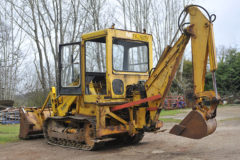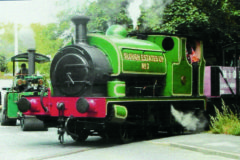A unique 1935 Fordson N
Posted by Chris Graham on 20th May 2022
Chris Graham meets Jonathan Boaz and his unique 1935 Fordson N that proudly carries a childhood memory-inspired, home-made cab.

Jonathan Boaz’s 1936 Fordson N, together with its home-made, 1930s-style cab, certainly catches the eye.
It’s not often that I come away from a visit with more questions than answers buzzing around in my head. But that was the case recently, following a trip to the Worcestershire farm that’s managed by tractor enthusiast extraordinaire, Jonathan Boaz.
I first came across the subject of this feature at last year’s Old Timer Tractor Rally, but knew nothing about its owner. As it turns out, Jonathan’s unusual, cabbed Fordson N is just the tip of the iceberg, in terms of the interesting machinery he owns.
He presides over a fantastic collection of more than 100 tractors – some of which are in his own museum – plus a fascinating assortment of hand tools, implements and other period curiosities, an ex-racing AJS motorcycle, a stationary engine with three-tonne flywheel, a Perkins diesel-engined Armstrong Siddley limousine and much else besides. His farm is a mechanically-themed Aladdin’s cave, with a wonderful variety of tractors dominating the content.
TVO-powered N
However, I’d visited to focus on just one machine; Jonathan’s 1935, TVO-powered Fordson N, and began our conversation by asking when and where he’d found it? “It was an old relic that I bought at one of the Cambridge vintage sales, probably 10 years ago,” he explained as we enjoyed a coffee in the farmhouse kitchen. “It was in quite a poor state, and was a tractor that had spent its working life on the Norfolk fens and, originally, I think it was registered in Norwich.
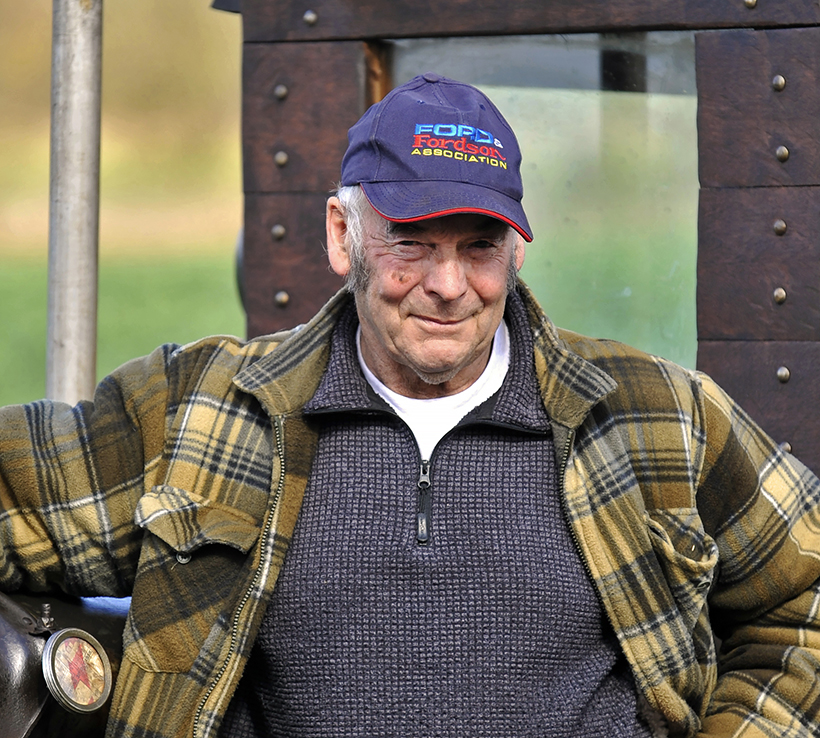
Jonathan has been collecting old tractors for several decades, and had amassed an impressive number of interesting Fordson and Ford machines, among many others.
“I’d stumbled upon it at the sale by chance, and hadn’t gone there looking for another Model N, but this one just caught my eye. It was a water-washer model, which I quite fancied and, from its outward appearance, it looked like a genuine and pretty much complete machine. On the downside, the engine was seized, the tyres were flat and the mudguards were in a sorry state.
“Obviously, the down-at-heal look was enough to put off a lot of potential bidders, and I was able to buy it for what was essentially ‘salvage money’. I certainly wasn’t fazed by the work it required, and was happy to add it to my collection. Once I got it home and took the cover off the tax disc holder, I found that it contained every disc from 1936 to 1962, which was an incredible bonus.
“To have a complete record of the tractor’s history, and proof that it had spent its whole life in the same area, was amazing. Judging by the state of it, though, I imagine that it had simply been stuck in a hedge when it stopped working sometime in the early 1960s, and left there to rot.”
Keeping it real!
Having assessed the tractor properly, Jonathan told me that he quickly decided that he didn’t want to re-paint it. “It just didn’t seem the right thing to do with this one; I typically get a gut feeling with tractors, about which should be preserved in their original condition, and which would be more suited to painting etc. So I opted to stabilise its condition and then preserve it in a way that would best reflect its age and life story.

This Standard N spent its working life in the Norfolk fens, and was first registered in Norwich.
“To be honest, I’m not a big fan of old tractors that have been restored to look better than when they left the factory. While some of the machines in my collection have been repainted and restored to a decent standard, I always ensure that the finished results are both authentic and sympathetic; never over-done. I can’t really see the point of creating a machine that can’t ever be run properly for fear of damaging its pristine condition. All my running tractors get used whenever possible, and that’s how I believe it should be.”
When Jonathan bought the N it was clear that the mudguards were in a sorry state, with typically extensive corrosion along the bottom edges, so the obvious options open to him were to repair or replace. However, as he told me, a pair of new ones would have probably cost more than he’d paid for the whole tractor, and they’d need to be painted which, as it had already been decided to leave the rest of the machine unpainted, didn’t make sense. “I was considering the steel repair section route when a childhood memory popped into my head,” he went on to explain.
“I have plenty of vivid memories of watching Fordson tractors hard at work on both my grandfather’s and my uncle’s farms in Worcestershire, back in the early 1950s. But, also from that time, I remember an old, long-abandoned tractor cab that I used to play in, and that’s the image that resurfaced in my mind as I was thinking about the way forward with this tractor.
“That cab was a home-built unit which, from memory, was a very simple structure made largely out of the metal from old oil drums. I assumed it would have only been used during the winter months, to provide a bit of rudimentary weather protection. Anyway, that recollection sent me off in a different direction. Why not ditch the mudguard repair idea altogether and fit a period-looking, home-made cab, instead?”
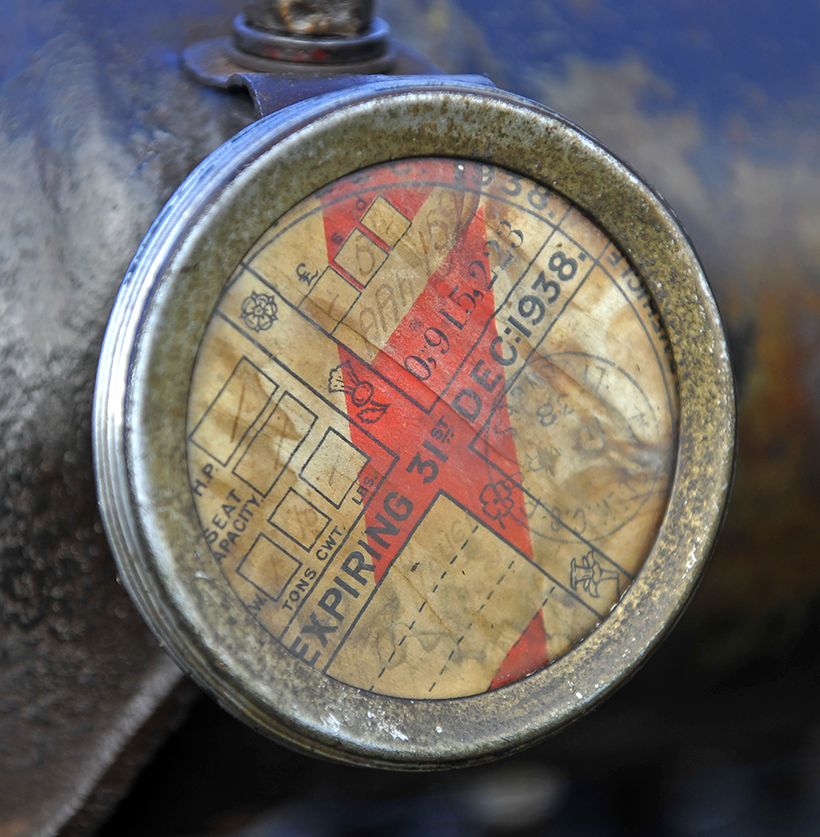
The tax disc holder was found to contain a complete set of discs, running consecutively from 1935 to 1962, at which point the tractor was presumably retired.
A novel idea
The more Jonathan thought about the idea, the more he liked it. “I knew that I’d be able to build my own version of the unit I’d played in all those years ago, and fitting it to the Model N would certainly create something rather different. I love owning tractors that are unusual for some reason, and building then fitting a cab in the style of the one from my childhood, would certainly achieve that. I was convinced that it would really set this little Fordson apart from the many other, standard-looking machines you see lined up at shows nowadays; I’ve seen very few fitted with cabs at all, let alone home-made versions.
“So I began making plans, and searching for the raw materials I reckoned I’d need for the job. I have plenty of salvage in the yard, and quickly found an old metal oil tank which I thought was about the right diameter to provide a suitably curved panel for the roof section. I also unearthed a large, square-shaped metal water tank with the remnants of a very mellow shade of bluish-green paint still clinging to parts of it. This colour wasn’t far off the shade in which the tractor would have been painted originally, so that seemed appropriate, as well.
So we set about cutting some flat panels from the square tank that could then be fitted to a basic cab frame that I’d made out of old angle iron. It was quite a simple structure to make. Window apertures were cut in the front and side panels, and I used glass salvaged from a Winsam cab that I had lying around.
I clad the top half of the cab with lengths of sawn-up scaffold board, then used some additional lengths of timber to form the frames for the windows, and to hold the glass in place. The cab was secured to the tractor via the original, cast iron mudguard brackets, which were still perfectly serviceable, using rivets. We used the original round, cast axle mountings which we riveted to the angle iron cab frame, This frame was also attached to six mounting holes on the cast dash panel, where the original ‘crows feet’ mudguard support brackets were once fitted.”
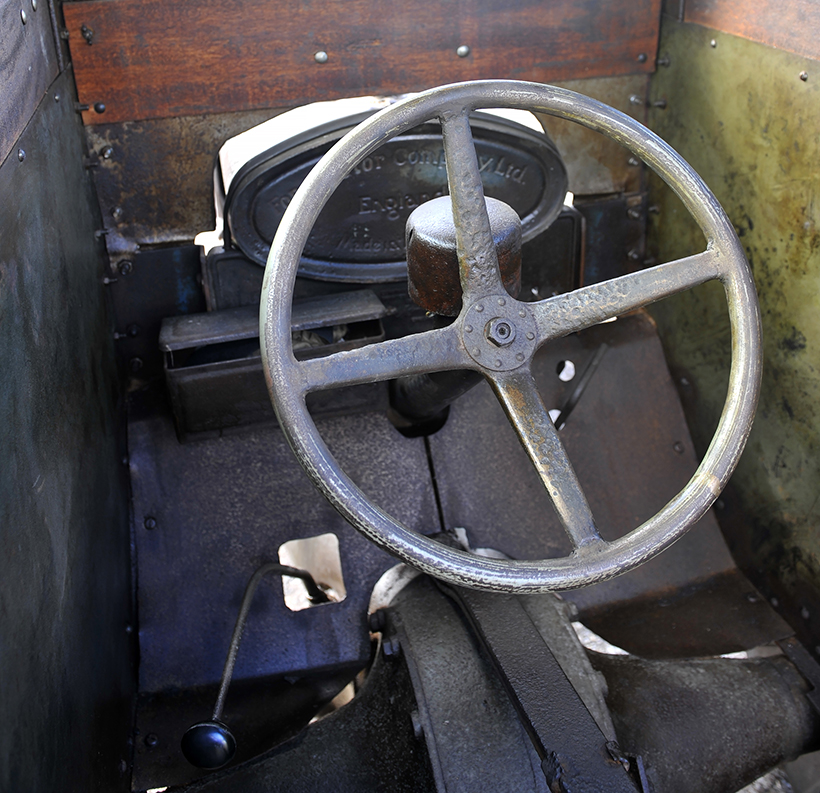
The cab provides rudimentary but rather noisy shelter from the elements, but is usefully warmed by a decent amount of heat from the TVO-powered engine.
Finishing touches
“As a finishing touch, I attached a rolled-up length of Hessian sacking (held in place with binder twine) to the back of the cab, to act as a very basic ‘door’ that can hang down across the back when needed. I also added the tractor’s original registration number across the front of the cab, above the ‘windscreen’, in a purposely amateurish, hand-painted way, then weathered it so that it looks suitably aged.
“My objective with the whole project was to create something that gave the impression of having been built in the 1930s, and I’m pleased with the way it’s turned out. It needed to be rustic and look old, which I think it does. Plenty of people have reacted by asking whether the cab is a genuine item from tractor’s past, which is exactly the effect I was hoping for, so I’m very pleased about that.
“Completing the cab certainly involved a lot of time and effort but, in terms of raw materials, it cost very little. But most of the time was probably spent thinking about the project and formulating the plan for the build; the actual mechanics of fabricating the parts, putting it together and then fitting it to the tractor, only took a couple of weeks.
“The finished result actually creates quite a cosy driving environment, with a useful amount of heat coming from the TVO engine. Of course, it’s noisy inside! As anyone with experience of the Fordson N will tell you, the gearbox and differential on these tractors always make a lot of noise, so building a metal box on top of this area inevitably creates something of an echo chamber! A few minutes spent in it certainly makes you appreciate how molly-coddled we all are today with modern machinery.

he cab has been built around an angle-iron frame, with side and front panels cut from a metal water tank, and the roof being made from a curved section of oil tank.
“But, back in the day, drivers would have worked for hour after hour in very similar cabs and, typically during the war years, it would have been Land Army girls having to endure the racket while at the controls. So I have nothing by respect for what those determined and adaptable youngsters achieved, especially given the working environment and wartime conditions.”
Getting it running
Elsewhere on the tractor, Jonathan had to deal with the engine. “This process doesn’t worry me,” he said, “Lots of the tractors I buy arrive with seized engines and I’m happy to say that I get most of them going. I have various techniques that I use and have made up jigs that allow me to wind seized pistons down under load. But, using this approach tends to be a last resort, as it can damage the pistons in the worst cases. However, I don’t think there’s one engine that I haven’t managed to get running again, one way or another.
“Ultimately, I think that any engine is recoverable, but whether or not it’s economically viable to do so is another matter. It all depends on your circumstances, of course; how much time and money you have to work with. After all, we’re not talking about repairing a £200,000 County here, we’re dealing with £2,000-£3,000-worth of Fordson Model N, so it’s very easy to spend too much, too quickly. Having said that, the sense of satisfaction I always get from finally starting an engine that may not have run for the past 50 or 60 years, is simply tremendous.
“This one now runs very sweetly, although it remains a bit unpredictable as far as starting is concerned. I think the impulse from the magneto probably isn’t what it should be, so that still needs looking at. In my experience, Fordsons from this era are typically challenging to start, and I think that no two the same. They all have their peculiarities, so it’s always a case of learning what those are. This is one of the reasons why I’ve converted so many of my tractors to run on easy-start, Perkins diesel engines!”
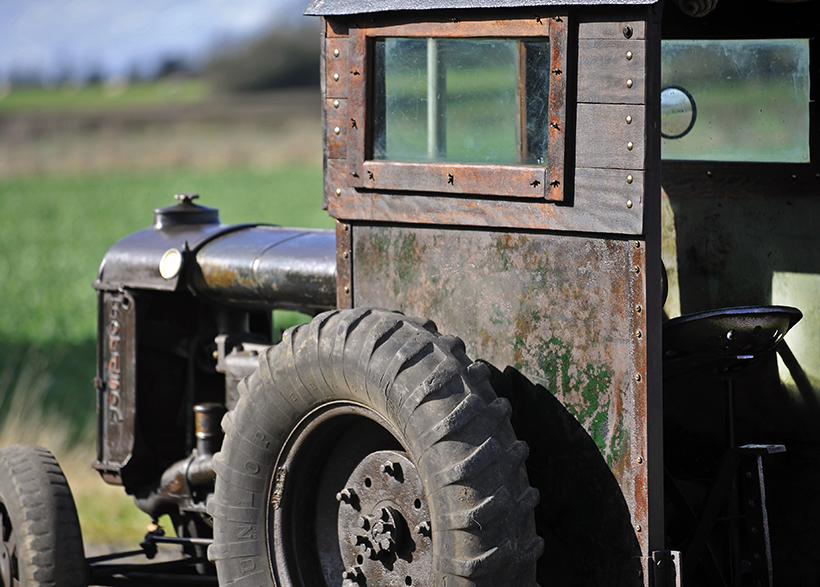
Jonathan has made an excellent job of ‘weathering’ the new cab, so that it matches the preserved, original condition of the tractor.
Continued growth
Jonathan is still adding to his collection, and had bought a couple more in the days before my visit. “As I’m getting on a bit now, though, I’m increasingly thinking that I ought to start selling a few but, so far, that just hasn’t happened. I freely admit that collecting tractors is a form of addiction, but it’s a healthy one and I do get an enormous amount of pleasure from owing them all. Although I’ve never bought tractors with a view to investment, that aspect is a comforting one nowadays; to know that if I needed to raise some money in a hurry, I have some assets that would be easy to convert into cash, is reassuring.
“Many of the machines I have have been with me for a long while so, even though their current values might not be particularly high, what they’re worth is considerably more than I paid for them. For example, I have a pair of Fordson E27Ns – one with a Perkins P6 engine and the other with a four-cylinder L4 – and I bought the pair about 40 years ago for £500! But, rather than looking at money in the bank, I prefer to be able to go out and see – and use – my tractors. I love the look of them, the smell of them, thinking about their history and wondering at everything they’ve done and the times they’ve experienced over the decades.
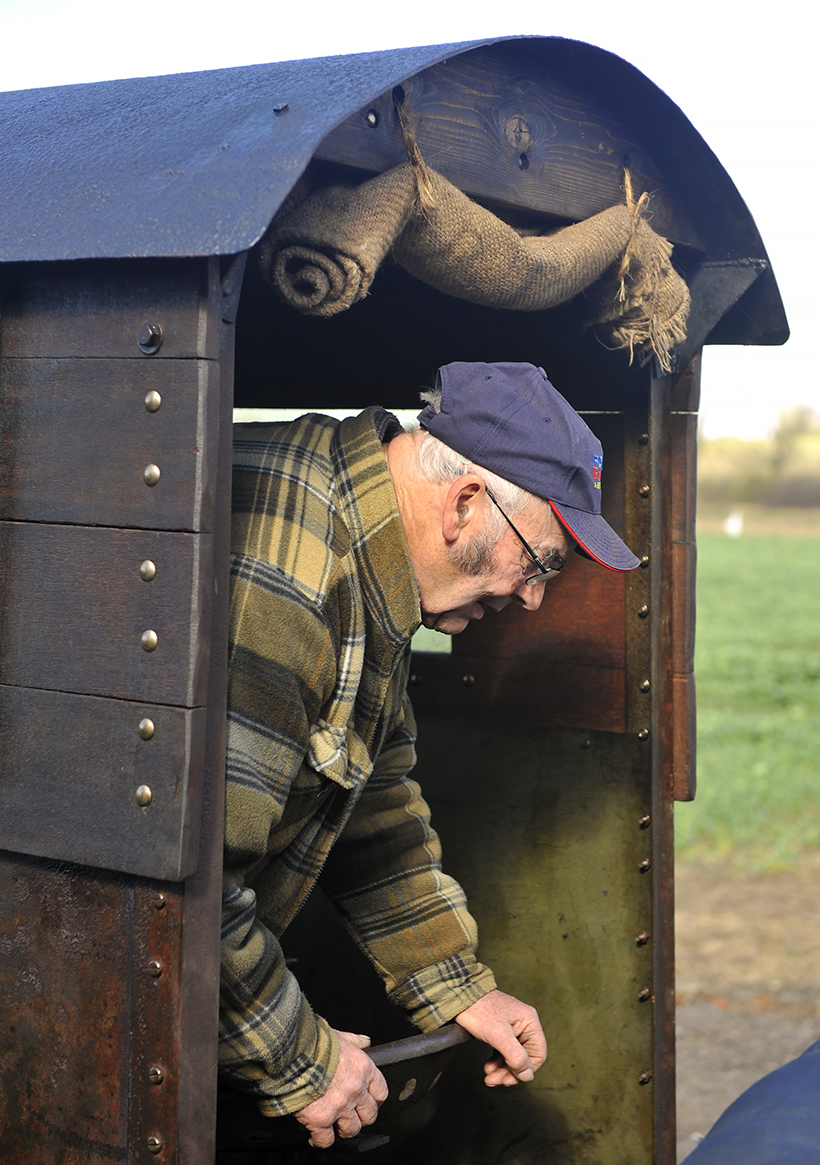
A roll of Hessian sacking, that’s rolled and secured with binder twin, can be lowered when the weather gets really cold!
“One of the beauties of this hobby is that you don’t need to be rich to get involved. There are tractors out there to suit all budgets and, if you’re prepared to get your hands dirty, then you can save even more cash. Obviously, there are exceptions, and the recent sale prices being made by selected County, Roadless and Muir-Hill models is incredible, but they are rarities. For the most part, classic and vintage tractors remain perfectly accessible to most people who are interested, and long may that continue.”
This feature is taken from the latest issue of Ford & Fordson Tractors magazine, and you can get a brilliant, money-saving subscription simply by clicking HERE



